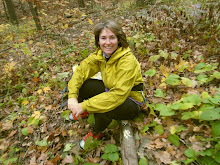
On October 11, 2008, my fellow Pittsburgh climber Dr. Amy Stine fell to her death while trad leading Streptococcus (rated 5.9 G) on the North Peak East Face of Seneca Rocks, WV.
The day Amy died was a beautiful fall day. She died doing what she loved, climbing, and she died from her fall instantly.
I had met Amy and her husband Bill, who belayed her on her last climb, through the sport we love. Amy was a joyful climber; and she climbed with much grace. Amy had Bill, who shared her love for climbing. Amy and Bill were out climbing together on many weekends. I remember vividly the pleasure of Bill and Amy's company around the camp fire at Princess Snowbird, where we tell the stories of our rock adventures.
It is almost two weeks later now, and still I struggle with my thoughts and feelings about the accident. Amy was the first climber I personally knew to perish on a climb. While knowing that trad leading has inherent dangers of injury and death, it is quite different experiencing the death of a fellow climber.
Climbing has risks, owing to environmental circumstance as well as human error, but l am quite aware of that at all times. I accept that risk. I manage that risk together with my climbing partners. I feel so alive when my body moves over the rock, when my mind is completely in the very moment, my motions are one with my mind.
When an accident happens, the ones close to us who do not climb raise their voices in concern. Why do you have to do this? Why do you climb?
My dad, an Olympic hopeful in rowing, understands and once articulated so well why I climb. He calls it the Koerpergefuehl, which the web tells me translates to coenesthesia. “Coenesthesia (according to dictionary.com) -- the aggregate of impressions arising from organic sensations that forms the basis of one's awareness of body or bodily state, as the feeling of health, vigor, or lethargy.” I climb because I love the bodily feeling of moving up on rock. But there is more. I love that climbing is complicated enough to completely absorb my thoughts and focus them in the moment and on task; because facing death helps me decide to continue to live. Once, while climbing, I experienced flow. This is something I have only felt climbing.
One of us was taken by the rock. What lessons have I learned from Amy's death?
To lead first and foremost requires that we lead ourselves.
The following options lay before me after Amy's death.
I could discontinue trad leading.
I could discontinue trad climbing.
I could stop to lead.
I could stop to climb.
Last Saturday I went back to Seneca to lead students from the University of Pittsburgh Outdoors Club. It was a very difficult experience. But I found that I had decided.
Knowing that I will continue to trad lead, the leadership questions in front of me now and for the future are different ones. How will I do even better to ensure the safety for all members of my team? How will I continue to bring to the outside the joy I feel on the inside when I climb? How will I do so in spite of all I know, and how will I share both, my knowledge and my joy, with others?
Lessons Learned from Amy: Climb for life.
Climb for the love of it.
Climb with people you love, and people you want to come to love.
Climb to better understand yourself and others.
Climb safely.
Climb with joy.
Amy's death was sudden. I chose the lyrics below as my death poem for her.
does anybody really know the secret
or the combination for this life
and where they keep it
its kinda sad when u dont know the meanin
but everything happens for a reason (everything happens for a reason)
i dont even know what i should say
cause im an idiot
a loser, microphone abuser
i analyze every second i exist
beatin on my mind every second with my fists
and everybody wanna run (wanna run)
everybody wanna hide from the gun (hide from the gun)
you can take a ride through this life if you want
but you cant take the edge off the knife (no sir)
and now you want your money back (money back)
but your denied cause your brains fried from the sack
and there aint nothin i can do
cause life is a lesson
you learn it when your through (Excerpt from Limp Bizkit – Take A Look Around. )



